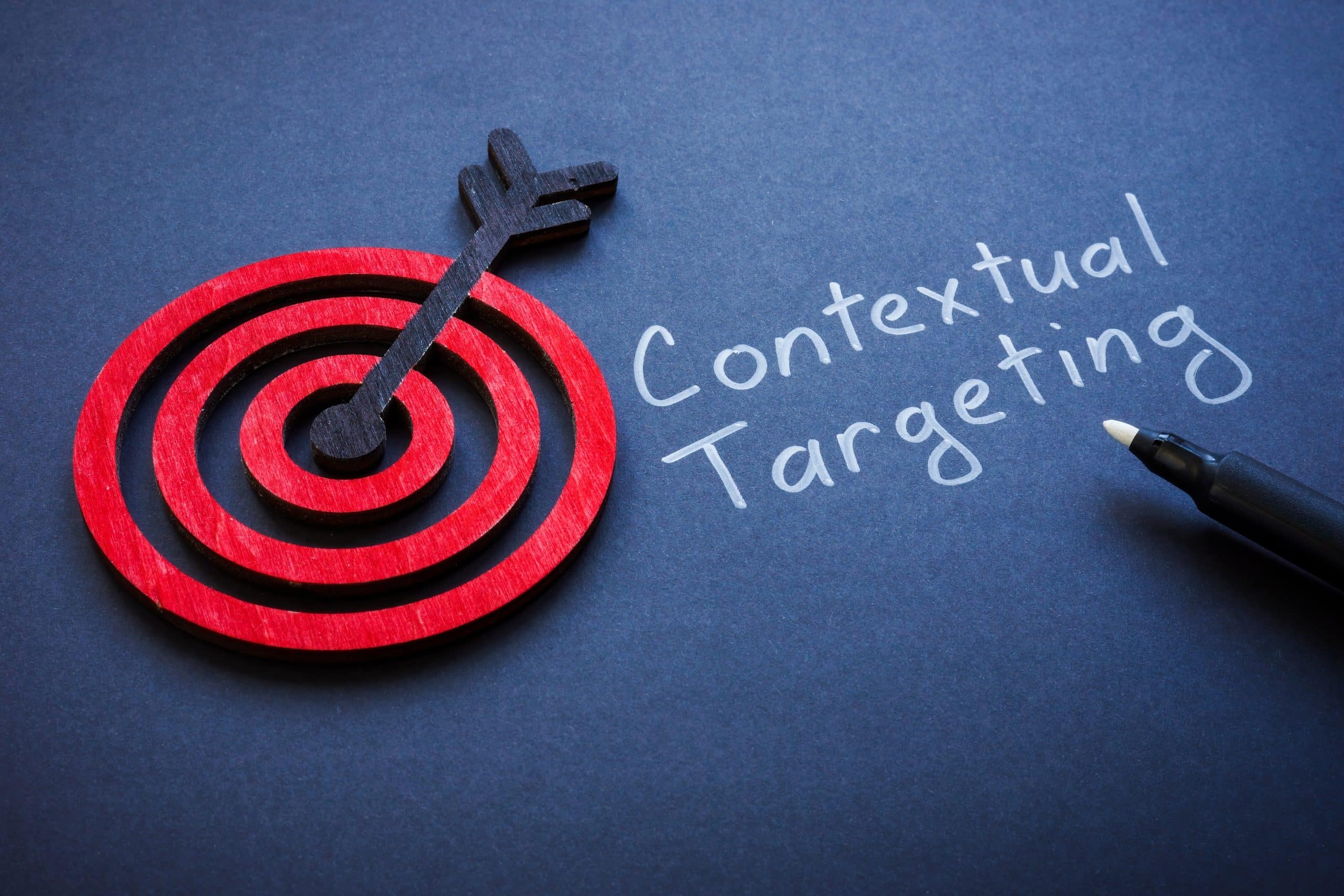- What Is Contextual Targeting?
- How Does Contextual Targeting Work?
- What Are the Benefits of Contextual Targeting?
- What Are the Limitations of Contextual Targeting?
- What Are the Different Types of Contextual Targeting?
- How to Implement Contextual Targeting in Advertising Platforms
- Is Contextual Targeting Privacy-Friendly?
- Contextual Advertising Campaign Strategies
- Contextual Advertising Performance and Measurements
- Contextual Advertising Optimization
- Contextual Targeting vs. Behavioral Targeting
- Contextual Targeting vs. Audience Targeting
- How Does AI and Machine Learning Enhance Contextual Targeting?
- Key Takeaways
- Frequently Asked Questions (FAQs)
In recent years, internet privacy laws have made it harder for marketers to harvest user data from websites, which previously allowed them to place relevant ad campaigns based on user demographics. Contextual targeting seeks to overcome this limit by placing ads based on the context of the web page, rather than user data.
What Is Contextual Targeting?
Contextual targeting is the first step in a form of programmatic advertising that places ads on platforms within an appropriate, relevant environment. Contextual advertising refers to the ad content being placed, while contextual targeting refers to the choice of platform or publisher where the ad runs.
Contextual targeting can be used in native advertising, display ads, on search engine results pages, in-app advertising, and more, for a true omnichannel approach.
Get access to top publishers, apps, and OEMs like Samsung, to maximize performance. Realize.
Contextual targeting allows brands to place relevant ads on websites and in other places without having specific user demographic data. Instead, ads are placed based on the surrounding context, established by keywords, meta-data, and other indications of the topic.
How Does Contextual Targeting Work?
Contextual targeting relies on the context — that is, the surrounding content — of a web page or other platform to place ads similar to the content. One study found that 69% of consumers are more likely to look at an ad that’s relevant to the content they’re currently viewing, while 44% have tried a new brand after seeing an ad alongside content they were viewing or reading.
As an example, if you’re reading an article about camping because you’re planning a trip, you’re more likely to respond to an ad for sleeping bags or a new tent. That’s contextual targeting at its best.
Sophisticated algorithms (powered by AI, in some cases) identify the correct context for ad placement without relying on any user data. Contextual targeting doesn’t know, or care, who you are, where you live, or how much money you make; it also doesn’t care what sites you’ve visited previously. You’re here now, and you’re reading about camping.
Since you’re reading about it, contextual targeting will assume you’re interested in camping and, as a result, may want to buy camping gear. This can significantly shorten the sales funnel, especially in a world that’s moving rapidly toward one-click or no-click search.
What Are the Benefits of Contextual Targeting?
Contextual targeting has many benefits, especially in an increasingly cookieless internet, where tracking behavior becomes harder without violating user privacy rights.
Reaches User in the Right Mindset and Ready to Buy
Performance marketing, although it’s focused on the decision-stage of the sales funnel, has potential to reach users at every stage of the sales funnel and shorten the cycle from recognition and research to buying. When people are consuming content on a specific topic, perhaps researching their options, they are already approaching “buy mode.” Contextual targeting, then, reaches people when they are most receptive.
Precision Targeting
Trying to reach a niche or even a micro-niche market? There’s content out there on virtually any topic. Contextual targeting helps you find that content and place relevant ads at the right moment.
Cost-Effective
Because you can reach your audience when they’re ready to buy, contextual targeting shortens the sales cycle and improves ROI.
Easily Scalable
With real-time performance data, certain contextual advertising platforms make it easy and affordable to scale.
Maintains User Privacy
Unlike behavioral targeting, which tracks users’ actions across the open web, apps, and other platforms to serve up relevant ads, contextual targeting focuses on the content, not the user. This eliminates the need for cookies or other data collection methods.
What Are the Limitations of Contextual Targeting?
Harder to Optimize
Contextual targeting relies on one factor alone to target users: the content they are consuming. This makes it harder to optimize, for instance, based on demographics like audience income, geography, or past shopping behavior. All targeting is based on keywords, meta data, and website topics.
Harder to Measure Performance Based on Audience
With a lack of user data, it’s harder to measure why a campaign is successful or who it’s converting. Advertisers only know their ad resonated with a specific reader, but they lack additional data. By combining contextual data with user demographic and user behavior data, though, you can create even more targeted, effective campaigns.
No Retargeting
Because contextual targeting doesn’t “follow” users, advertisers miss the opportunity to share similar content across platforms and build affinity through familiarity.
What Are the Different Types of Contextual Targeting?
To determine proper ad placement, contextual advertising platforms must evaluate the content. There are three primary ways to do so.
Keyword
Gauging topics through keywords is, perhaps, the most straightforward way to identify the right content for contextual ads. It can lead to an accurate match — for instance, an ad for a Nissan Rogue might appear near an article reviewing the best compact SUVs of the year.
That said, relying on keywords alone can also cause mistakes if keywords have two meanings, are unclear, or you’re trying to reach a more nuanced market. For instance, B2B advertisers might find themselves reaching consumers searching for similar keywords. Additionally, if a website in the advertising network isn’t using keywords properly or effectively, it could result in less accurate targeting.
Category
For broader reach, advertisers might choose content based on broad categories or topics. For instance, an e-commerce company that sells luggage could place ads on a Prime Day suitcase round-up if they used a keyword-based strategy, but they could reach a larger audience by targeting broad-based articles about travel or planning a trip.
Semantic
Finally, sophisticated advertising platforms use AI-powered analytics to pinpoint ad placements based on multiple factors: keywords, context, topics, and even user sentiment and intent. This is important, since research shows that people are 20% more engaged when viewing content on platforms they view positively, and also spend 15% more time looking at ads on those platforms. By using software that gauges user intent and sentiment while consuming content, advertisers can place ads where they will have the most impact.
How to Implement Contextual Targeting in Advertising Platforms
When you’re ready to get started, the process for implementing contextual targeting varies depending on the platform. In all cases, you want strong creative, and you want to make sure you’re targeting the right audience.
Google Ads
In your Google Ads account, under Content, click Campaigns. Then, select “content” from the dropdown menu. Google uses keywords and topics to choose display ad placements. You can also choose specific websites that allow display ads.
DV360
DV360, or Google Display & Video 360, is a robust programmatic advertising platform owned by Google. By its nature, it’s more complicated to use than Google Ads, but it allows marketers to manage campaigns across channels, aligning media, data, and creative.
To get started, you’ll want to create an insertion order that includes your budget and pacing. Choose whether you want display or video advertising. Then, the key part comes in: Select your targeted keywords, choose a category, and then choose any specific websites, apps, or channels. You can also exclude negative keywords.
Finally, DV360 will show your potential reach, and you can adjust your settings to broaden or narrow the reach. You can optimize as you go by monitoring performance and adjusting keywords or categories.
Meta
While Meta advertising does not offer contextual targeting, you can replicate the results by choosing interests, behaviors, and page categories you want. Meta uses a combination of interests, demographics, and behaviors, but it won’t be as exact as pinpointing contextual targeting through a DSP with contextual capabilities.
TikTok
Advertisers can use the TikTok Pulse Suite to place ads next to related user generated content, or next to premium content from top brands like Disney, NBC Sports, or top digital publications like BuzzFeed. Ads can be placed surrounding tentpole events, like the Super Bowl, or adjacent to evergreen content. TikTok offers ad placements to fit different budgets, depending on the Pulse product you choose.
Realize
Realize places your ads on top-performing websites so that your reach expands far beyond the walled gardens of search and social. Realize uses first-party data and AI trained on 17+ years of proprietary data to deliver ads to consumers who are in the consideration and action stages of the sales funnel, for faster conversions.
To get started, create an account and you’re on your way. The Campaign Performance Simulator can help you gauge the success of your ads before you spend a dollar, allowing you to estimate potential conversions based on your CPA (cost per action/acquisition) and budget.
Is Contextual Targeting Privacy-Friendly?
Unlike advertising strategies that require collecting user data to create lookalike audiences or using cookies to track past consumer behavior, contextual targeting preserves user privacy. It doesn’t require cookies or any user data: Contextual targeting cares about what the prospects are watching or viewing, not who they are. So, if you’re reading a top 10 list of camping gear, they don’t care if you’re a 25-year-old man or 65-year-old woman. Your actions, not your demographics, indicate your intent and your interest.
Contextual Advertising Campaign Strategies
Marketers can choose their contextual advertising campaigns based on keywords, categories, or semantically (i.e., analyzing the web page as a whole, going beyond keywords to look at user intent, the credibility of the website, and a host of other factors). Let’s consider the pros and cons of each.
Keyword Strategy
Highly effective, but limited, using a keyword strategy for contextual advertising relies on thinking in the same language as your ideal customers. Keywords can open your campaign up to misunderstandings, though: For example, if your ideal reader is searching for the best types of apples vs. Apple technology, they might stumble upon your ad for an iPhone case when they’re looking for the best orchard to go apple picking. That’s an obvious, and broad example, but subtle nuances can make a difference when you’re trying to find your ideal customer via keyword matching.
Categories
Placing ads based on categories, such as “smartphone technology,” may help you find those iPhone users that need a new case. But, you might also find people looking for a new phone or for ways to use their smartphone.
Semantics
Determining ad placements through semantics overcomes the challenges of categorical or keyword campaigns by using AI to determine context based not just on keywords and categories, but user intent, images, and even the reputation of a website overall, and the page’s author.
Contextual Advertising Strategy Success Tips
To create a successful strategy:
- Use a mix of tactics to determine your target audience.
- Clearly define your campaign objectives.
- Develop eye-catching, informative creative.
- Test your ads and placements.
- Track your results.
- Refine your campaign.
Contextual Advertising Performance and Measurements
Understanding your goals for a campaign helps you track and refine your creative and your targeting for greater success. Some possible goals for middle- and bottom-of-the-funnel (BOFU) campaigns include:
- Signing up for a newsletter.
- Providing their email for a content asset (lead generation).
- Making a purchase.
- Downloading an app.
A metric for these would be “cost per action” or “CPA.”
Understanding and Tracking Key Performance Indicators (KPIs)
Metrics can help show the success of a campaign. If your goal is new customer acquisition, e.g., your KPI might be measured as cost per acquisition (CPA). You can also track Return on Ad Spend (ROAS), which indicates how much money you make on each ad you place. It’s calculated as ad spend for that campaign divided by total sales from that campaign.
Contextual Advertising Optimization
Optimizing your contextual advertising campaigns involves tracking results and seeking ways to improve your KPIs.
A/B Testing
A/B testing, where you run multiple campaigns and change one facet of each one to optimize performance, is one of the most common ways to optimize your contextual campaign. You can adjust a variety of factors in your contextual targeting:
- Campaign dates and times: If you’re planning a campaign around a specific date, you can use historical data to determine how soon to start pushing out related creative. But, you’ll also want to experiment with specific days of the week and times of the day.
- Ad creative: Test multiple versions of your creative, switching up headlines, tags, colors, images, and more.
- Channels: Think beyond search and social when you’re testing various channels for your campaign.
Doubling Down on What Works
Once you’ve drilled down to the most successful combination of creative, timing, and placement, increase your ad spend until you’ve exhausted the market and started to see diminishing returns.
Contextual Targeting vs. Behavioral Targeting
Behavioral targeting focuses on what your audience has done in the past to predict future behavior. It often relies on cookies and as such can create privacy concerns. It may also not be reliable, as it may reach consumers after they’ve made their buying decision, e.g., if a user has previously visited several car dealership websites and clicked on ads for new cars in recent weeks, behavioral targeting would continue to show those ads, even after the customer has purchased a car.
With contextual targeting, it’s highly likely a consumer who has already purchased a car would no longer be reading or viewing content on the best cars; they wouldn’t see an ad placed near a list of the top 10 SUVs. Your creative would reach consumers who are still in the consideration phase and potentially ready to buy.
Contextual Targeting vs. Audience Targeting
Audience targeting, often called “lookalike” targeting or predictive targeting, seeks out people similar to your existing customers. This tactic can take advantage of first-party data, such as information from your CRM, to create campaigns without using third-party cookies. It relies on the assumption that your audience demographic has similar traits and interests: Data like age, occupation, income, and geography may be useful in finding your ideal audience.
Audience targeting may also pull from data like how a user navigated your website, topics they are currently reading, or keywords they have searched. This can be a solid tactic to expand your reach, especially if your predictive data is accurate and reliable.
How Does AI and Machine Learning Enhance Contextual Targeting?
Artificial intelligence, large language models, and machine learning contribute to more accurate contextual targeting. Rather than looking at keywords alone, Performance AI can analyze user intent, semantic themes, photos, and more. This allows for more meaningful matches, even without cookies. Machine learning also allows you to drill down to more specific market segments in real time, enabling you to scale your campaigns faster and reduce your overall ad spend.
Key Takeaways
Contextual targeting can match your ads to relevant content based on keywords, categories, or semantic context. Using semantic targeting coupled with AI and machine learning can deliver better results in less time, since this method analyzes every aspect of the media to determine the topic down to a granular level, as well as user intent. Contextual targeting also helps maintain user privacy, and addresses the challenges of audience targeting as websites move away from using cookies that track user behavior.
Frequently Asked Questions (FAQs)
Does contextual targeting still work in a cookieless world?
Contextual targeting is uniquely suited for a cookieless world, since it does not rely on user behavior to match ads with users.
What is semantic contextual targeting?
Semantic contextual targeting evaluates content based not just on keywords or category, but user intent, images, videos, and the overall meaning of a web page, to place relevant ads.
What are contextual keywords?
Contextual keywords help digital advertising platforms implement the proper placement for ads, by determining the goal of a web page based on words used in the content.
How does contextual targeting work for video advertising?
Marketers can use contextual targeting in video advertising by placing ads in content related to their topic. For instance, if someone is watching a video review of the latest Ford truck, Nissan might place an ad for their truck within the video.
Can contextual targeting be used for content recommendations?
Contextual targeting is highly effective for content recommendations, as it can assess what a user is viewing or considering and recommend similar content.



